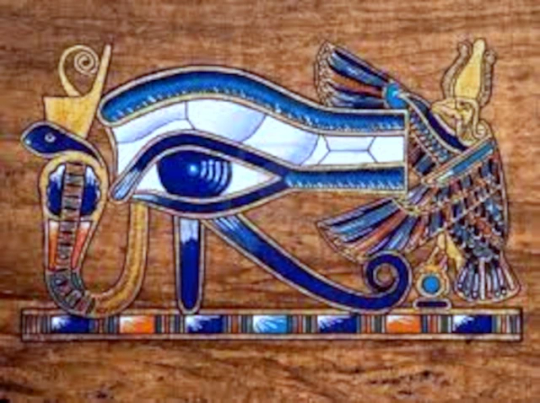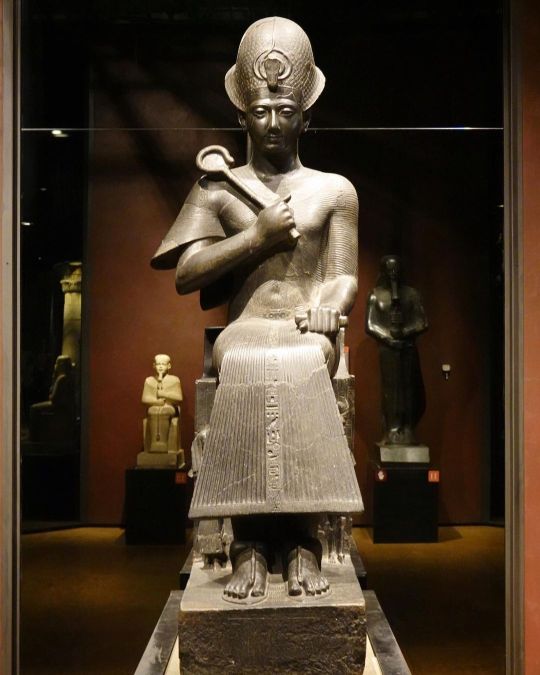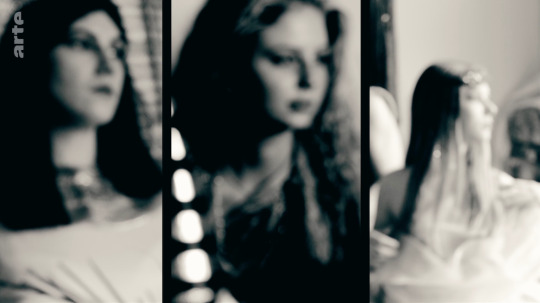#ramsesiii
Photo

Ramses III Making Incense Offering to Amun at Medinet Habu 𓂦𓂋𓏏𓋀𓏏𓏏 “ḏšr.t ı͗mnet.t” ‘the sacred west’ Notice the unique and unusual placement of the sun-disk 𓇋𓏏𓈖𓇳 “ı͗tn” on the top of the head 𓁷𓏤 “ḥr” of Ramses III (𓁛𓄟𓊃𓊃𓋾𓈎𓉺) “rˁ-ms-s ḥq3-iwnw”, this was reserved strictly for the gods 𓊹𓊹𓊹 “nṯrw” such as Ra, Hathor, Sekhmet, Tefnut, Khonsu, etc. Ramses III is dressed in a high status regalia and offers the state god, Amun 𓇋𓏠𓈖𓁩 “ı͗mn” ‘the hidden one’, burning incense 𓊹𓌢𓏏𓂋𓏸𓏬 “snṯr” in a traditional posture of devotion. Usermaatre-Meryamun Rameses III was the second Pharaoh 𓉐𓉼 “pr-ˁ3” ‘Great House’ of the Twentieth Dynasty in Ancient Egypt. He is thought to have reigned from 1186-1155 BC and is considered to be the last great monarch of the New Kingdom to wield any substantial authority over Egypt - Black Land - Kemet 𓆎𓅓𓏏𓊖 “kmt” His long reign saw the decline of Egyptian 𓂋𓐝𓎀𓀂𓀭𓏪 “rmṯ” political and economic power, linked to a series of invasions and internal economic problems, such at the rising power 𓊪𓎛𓏏𓄇𓄇 “pḥty” of the priesthood, that also plagued pharaohs before him. This coincided with a decline in the cultural sphere of Ancient Egypt. 📸 @peter.copek (thank you for the high-res image) 𓋹𓎬𓋹𓎬𓋹𓎬𓋹𓎬𓋹𓎬𓋹𓎬𓋹𓎬𓋹𓎬𓋹𓎬𓋹𓎬𓋹𓎬𓋹𓎬𓋹𓎬𓋹𓎬𓋹𓎬𓋹𓎬 @egyptologylessons 𓋹𓊽𓋴𓆖𓎛𓇳𓎛 𓊁𓊁𓊁𓊁𓊁𓊁𓊁𓊁𓊁𓊁𓊁𓊁𓊁𓊁𓊁𓊁𓊁 #Ancientegypt #ägypten #egyptianhistory #egyptology #hieroglyphs #egypte #egitto #埃及 #مصر #egipto #이집트 #ramsesiii #medinethabu #amun #temple #incense #offering #pharaoh (at Medinet Habu) https://www.instagram.com/p/CjDuafKOIUU/?igshid=NGJjMDIxMWI=
#ancientegypt#ägypten#egyptianhistory#egyptology#hieroglyphs#egypte#egitto#埃及#مصر#egipto#이집트#ramsesiii#medinethabu#amun#temple#incense#offering#pharaoh
98 notes
·
View notes
Photo

First flowers bouquet in the history where founded in the Tomb of the High Priest Setaw / El Kab / Edfu / Aswan High Priest of Nekhbet during the reign of Ramses III until the reign of Ramses IX during the Twentieth Dynasty. El Kab is located near the current village of Mahamid in the north of the city of Aswan, about 120 km to the east of the Nile and on the edge of the Eastern Desert, and is located about 20 km from the city of Edfu in the north-east and at a distance of about 83 km south of Luxor. It was the capital of Upper Egypt in prehistoric times, and later became the capital of the third region for a period of more than three thousand years, until the rule of the Ptolemaic era and even the Byzantine times. As it was one of the important religious centers, it witnessed days of glory and greatness since prehistoric times. 🇪🇬 #iregipto #egyptpassion #mbplanet #history #aswanegypt #elkab #edfutemple #ramsesiii #roses #flowers #ptolemaic https://www.instagram.com/p/CfcdmR_PqbT/?igshid=NGJjMDIxMWI=
#iregipto#egyptpassion#mbplanet#history#aswanegypt#elkab#edfutemple#ramsesiii#roses#flowers#ptolemaic
34 notes
·
View notes
Photo

"Complot contre Ramsès III" documentaire de Keti Vaitonis (2021), mai 2023.
0 notes
Text
Considerazioni sulla tradizione magica egiziana

In questo articolo ci interesseremo degli elementi principali della tradizione magica egiziana .
Al contrario di quanto si pensava nel mondo classico i testi scoperti nell’era moderna dimostrano che la magia egiziana era un’arte estremamente evoluta.
Nella religione egizia Heka era la deificazione della magia essendo il suo nome abitualmente tradotto con magia o forza soprannaturale.
Secondo i testi egiziani Heka esisteva “ prima della nascita della dualità” .
Il termine Heka è usato anche per la pratica dei riti magici .
Heka nella religione egiziana era colui che attivava il Ka , l’aspetto dell’anima che incorporava la personalità.
Gli egiziani erano convinti che la magia agisse attivando la potenza dell’anima .
Heka agiva insieme ad Hu il principio della parola divina sia nel mondo mortale che in quello divino .
Heka essendo uno che attivava il Ka veniva anche definito figlio di Atum creatore delle cose in generale .
La magia per gli antichi egiziani permeava ogni cosa nella creazione e come tale tutte le cose nella creazione possedevano Heka in una certa misura .
Ogni antico egizio a suo modo era un mago e prendeva parte al potere che gli dei avevano dato agli uomini di agire sul mondo reale.
La comprensione dell’Heka dava la possibilità al sacerdote / mago di compiere i riti magici .
Di conseguenza egli più Heka acquisiva maggiore era la capacità di compiere riti magici.
La magia in Egitto a differenza di quella occidentale non veniva divisa in magia nera e magia bianca ma in una “magia inferiore” e in una “ magia superiore”.
La magia inferiore era la magia del mondo fisico della salute , del danaro e della fortuna mentre la “magia superiore” era associata allo spirito.
Per gli antichi egizi la magia era stata donata dalla divinità agli uomini per respingere le avversità.
Di conseguenza essa era un modo per combattere in maniera efficace il destino avverso.
Diversi erano i tipi di magia utilizzati dagli antichi egizi : magia scritta ,magia delle parole , magia simpatica ,magia con amuleti.
Per quanto riguarda la magia scritta dobbiamo dire che essa era molto utilizzata sulle pergamene e i testi sacri e sulle mura delle case.
A sua volta la magia delle parole era basata sul principio secondo il quale la parola nell’antico Egitto era considerata sacra e creatrice.
Infatti nel Libro dei Morti stava scritto : “ che i tuoi pensieri siano i grandi incantesimi magici che escono dalla tua bocca “.
Nell’antico Egitto la formula magica era l’arma più potente del mago .
Di conseguenza la sua corretta pronuncia era essenziale per l’efficacia del rito magico.
Non dobbiamo dimenticare che secondo gli antichi egiziani l’intero universo era costituito da vibrazioni cosicchè le vibrazioni davano luogo ad effetti .
Esse potevano assumere la modalità del comando o della preghiera al Neter .
Esso era per gli egiziani un aspetto di Dio.
In tal senso l’Heka di cui abbiamo parlato in precedenza era l’energia latente in certe parole di potenza e in certi gesti rituali .
I sacerdoti egiziani erano pertanto considerati potentissimi signori della Parola .
La magia del nome era di fondamentale importanza nell’antico Egitto dal momento che era considerata di fondamentale importanza conoscere il nome segreto dell’essere .
Infatti il nome segreto racchiudeva l’essenza dell’essere cosicché conoscerlo significava averne il dominio .
Per quanto riguarda la magia simpatica dobbiamo dire che era quella per cui celebrando un rito magico su una parte appartenente ad una persona o una cosa si determinò un effetto che dalla parte si trasferiva all’intera persona o cosa .
Ciò avveniva anche se la persona o cosa erano assenti e distanti dall’evento magico .
A tale scopo venivano usate immagini contenenti qualcosa della vittima del rito magico .
Per fare un esempio concreto questo tipo di magia fu usato contro il re Ramses III da un gruppo di sacerdoti e cortigiani .
Questi cospiratori entrarono in possesso di un libro di magia distruttiva della biblioteca reale e lo utilizzarono per fare pozioni incantesimi scritti e figurine di cera con cui danneggiarono il re e le sue guardie del corpo.
Si riteneva che le figurine magiche potessero essere più efficaci se contenevano qualcosa della vittima designata come capelli unghie etc.
I cospiratori furono poi processati per stregoneria e condannati a morte .
Gli amuleti nella magia egiziana erano molto utilizzati come protezione dagli attacchi magici .
Per gli egiziani antichi l’alba era il momento più favorevole per effettuare riti magici.
Le attività magiche venivano utilizzate per protezione guarigioni e maledizioni.
Per la protezione venivano utilizzati esclusivamente amuleti mentre la magia a scopo medico era considerata non tanto come alternativa alla medicina bensì una terapia complementare .
I sacerdoti nell’antico Egitto erano tutti guaritori .
Medicina e guaritori erano considerati rami della magia tanto che i sacerdoti di Heka svolgevano anche questi compiti.
Per quanto riguarda l’uso delle maledizioni esso era limitato .
Ad esempio venivano maledette le tombe dei faraoni allo scopo di scoraggiare i ladri a profanare quei luoghi .
Inoltre venivano utilizzati i testi di esecrazione che erano frasi con le quali nell’antico Egitto si cercava di allontanare danneggiare o eliminare i nemici .
I testi di esecrazione si utilizzavano anche per colpire i concittadini che erano diventati dannosi o pericolosi .
Tali testi abitualmente venivano scritti su vetri o su cocci di argilla o ceramica .
Più che atti religiosi essi erano atti di magia che avrebbero dovuto produrre il loro effetto automaticamente
L’antico Egitto è la fonte più ricca di questi testi di esecrazione che diventavano più numerosi nei momenti di crisi nei rapporti con le nazioni vicine .
Ma queste attività magiche erano presenti anche in altre culture .
Come molte cose dell’antichità anche la magia egizia andò incontro a un processo di degenerazione nel corso del passare del tempo .
Detto ciò riteniamo concluso il nostro discorso sulla magia egiziana.
Prof. Giovanni Pellegrino
Read the full article
#Egitto#Keka#lLibrodeiMorti#magia#MagiaEgiziana#magiasuperiore#Neter#RamsesIII#sacerdoti#spirito#stregoneria#wicca
0 notes
Photo

Exposition Pharaon des deux Terres : l’épopée Africaine des Rois de Napata : Stele triomphale de l’an 21 du roi Piankhy, Taharqua et la nuit de Juliette Agnel, Harpe aux cartouches de Ramses III, Statue du belier d’Amon protégeant Amenophis III. #museedulouvre #pharaondesdeuxterres #lépopéeafricainedesroisdenapata #an21 #taharqua #julietteagnel #harpe #cartouches #ramsesiii #soleb #belier #amon #amenophisiii #ɪɴsᴛᴀᴘɪᴄ #photooftheday📷 #parismaville🙏 (at Musée du Louvre, Paris) https://www.instagram.com/p/CfXOmvILHU5/?igshid=NGJjMDIxMWI=
#museedulouvre#pharaondesdeuxterres#lépopéeafricainedesroisdenapata#an21#taharqua#julietteagnel#harpe#cartouches#ramsesiii#soleb#belier#amon#amenophisiii#ɪɴsᴛᴀᴘɪᴄ#photooftheday📷#parismaville🙏
0 notes
Photo

#lamortdepharaon #simonnelacouture #ouibonbofquoi #ramsesIII (at Karnak Temple, Luxor) https://www.instagram.com/p/CdnMVAuMV0b/?igshid=NGJjMDIxMWI=
0 notes
Text

Egypt preserved much knowledge of the Bronze Age which would have been lost due to destruction by a roving coalition of displaced itinerants known collectively as the Sea Peoples. These desperate people were displaced from their homes in southern Europe due to drought, famine, earthquakes and seismic activity and were forced to migrate and in so doing inundated or conquered much of what is now Greece, Turkey, Crete, Cyprus and Syria. They sought to invade Egypt but in the 1270’s BC the pharaoh Ramses III, grandson of the 3rd who was one of Egypt’s greatest rulers, stopped the onslaught at the land battle of Djahy, near southern Lebanon. Racing back to Egypt to defend against a huge armada of Sea Peoples ships, Ramses lured their vessels into the Nile delta and destroyed their flotilla in a great battle, causing msny of the invaders to drown and taking the rest prisoner. These victories secured Egypt for a time, long enough for scribes to collect scrolls and records or compose accounts of the ancient world and pass this information on centuries later to the Greeks and Romans. Ramses was the victim of palace intrigue and was assassinated, but he is considered the last of the great pharaohs. #ancientegypt #egypt #seapeoples #ramsesIII #bronzeage #ancienthistory
1 note
·
View note
Photo

Depictions of the underworld inside the tomb of Ramses III. The 3-headed serpent is rather interesting! This is an incredibly well-preserved tomb in the Valley of the Kings...its beautifully decorated with bright colors to this day (it’s from around 1200 BC!) if you find yourself in Egypt one day...I highly recommend a journey down to this tomb! (More info about the Valley of the Kings via the link in my bio.) • • • • • • #expediapic #egypttravel #orbitzpic #uniladadventure #sheisnotlost #sidewalkerdaily #ladiesgoneglobal #dametravel #travel #travelgram #discoverglobe #theglobewanderer #tlpicks #travelholic #bestvacations #wonderfulglobe #travelblogger #ramsesiii #ramsesiiitomb #hieroglyphics #worldnomads #haveclotheswilltravel #travelegypt #luxor #valleyofthekings #valleyofthekingsegypt #luxoregypt (at Tomb of Ramses III (KV11)) https://www.instagram.com/p/B0RbxMMhINk/?igshid=16wqjvb390kvq
#expediapic#egypttravel#orbitzpic#uniladadventure#sheisnotlost#sidewalkerdaily#ladiesgoneglobal#dametravel#travel#travelgram#discoverglobe#theglobewanderer#tlpicks#travelholic#bestvacations#wonderfulglobe#travelblogger#ramsesiii#ramsesiiitomb#hieroglyphics#worldnomads#haveclotheswilltravel#travelegypt#luxor#valleyofthekings#valleyofthekingsegypt#luxoregypt
3 notes
·
View notes
Photo

From 2019 Sept 05 - Valley of the Kings Me with Ramses III. I was just hanging out with him the other day at his temple in Karnak. . . . The Screaming Man. Ramses' mummy was found in the stash of mummies at Dier El Bahari. But there was another body with his and it was not embalmed. It was a man that looked to have died in agony. There was indication that the man's wrists and ankles were bound. The internal organs and brains were not removed as was the usual practice in the mummification process. Also, the corpse was wrapped in a simple sheepskin which is pretty shabby when it comes to traveling to the next life. As it turns out, with DNA testing, this horribly kept body had a filial connection to Ramses III. It was most likely Pentaware, the son who conspired to usurp the throne, kill his father, and also kill his half-brother Ramses IV. .. .. .. .. .. .. .. .. #travel #africa #egypt #westbank #thebes #luxor #ancientthebes #necropolis #temple #KV11 #ruins #tomb #ramsesIII #ancienttemple #history #ancienttomb #ancientcity #ancienthistory #unesco #worldheritagesite #hieroglyphs #unescoworldheritagesite #ancientruins #egyptology #archeologicalsite #waset #valleyofthekings #royaltombs ... ... #egypttoursportal Tour day 7 with @egypttoursportal https://www.instagram.com/p/B2Xei5YgKUI/?igshid=1nxteneor5vmv
#travel#africa#egypt#westbank#thebes#luxor#ancientthebes#necropolis#temple#kv11#ruins#tomb#ramsesiii#ancienttemple#history#ancienttomb#ancientcity#ancienthistory#unesco#worldheritagesite#hieroglyphs#unescoworldheritagesite#ancientruins#egyptology#archeologicalsite#waset#valleyofthekings#royaltombs#egypttoursportal
1 note
·
View note
Photo

No Vale dos Reis, em Luxor, há mais de 60 tumbas de faraós e nobres. A crença na vida após a morte está na base do processo de mumificação, do ornamento nas tumbas e de todos os tesouros lá deixados. Pena que a imensa maioria foi pilhada ao longo do tempo. Mas o que restou, como nessa tumba de um dos faraós Ramses, dá uma pequena amostra do que era a perspectiva de vida para além da vida: um luxo! 😁 #egito #egipt #valedosreis #luxor #ramsesiii #netepelomundo (em Valley of the Kings وادي الملوك) https://www.instagram.com/p/BzUzbiZF2AN/?igshid=svaaim67s1pi
0 notes
Photo

Granodiorite Statue of Ramesses II The king 𓇓𓏏𓈖 “nsw” is depicted in all his majesty. He wears the khepresh crown 𓆣𓂋𓈙𓋙 “ḫprš” and holds the heka sceptre 𓋾𓏘𓄿 “ḥq3” against his chest. His transparent pleated ceremonial dress reveals his muscled body 𓄡𓏏𓏤 “ẖ.t”. Under his sandals 𓍿𓃀𓏏𓋸𓋸 “tjbw.ty” he tramples the Nine Bows 𓌔𓏏𓐂 “psḏ.t”, symbols of the enemies 𓐍𓆑𓏏𓏭𓀏 “ḫfty” of Egypt. On the sides of the throne 𓊨𓏏𓉗 “3s.t” is carved the sema-tawy 𓋍, the knotted heraldic plants of Upper and Lower Egypt representing the union of the Two Lands 𓇾𓇾 “t3wy”. Dynastic continuity is expressed by the figures of his wife Nefertari (𓏏𓅐𓄤𓇋𓏏𓂋𓏭𓈘𓏏) “nfr-tı͗-rı͗-mrı͗.t-mwt” ‘Beautiful Companion, Beloved of Mut’ and his son Amunherkhepeshef on either side of his legs. The long reign of Ramesses lI (𓇳𓏤𓄟𓋴𓇓) “rˁ-msi-sw” ‘Him, Born of Ra’ probably witnessed a stylistic evolution of the royal portrait. The statue 𓂙𓏏𓏭𓀾 “ḫnty” probably belongs to the beginning of the reign of Ramesses I. In any case, it can be no later than the first half of the reign, due to the presence of Queen Nefertari, who died in year 30, This statue is one of the symbols of the @museoegizio In a letter that he wrote during his stay in Turin in 1824, Champollion describes with enthusiasm "the beauty and the admirable perfection of this colossal figure (….): for six whole months I have seen it every day, and always I have the impression of seeing it for the first time. The head is divine, the feet and hands are admirable, the body is voluptuous; I call it the Egyptian Apollo of the Belvedere... in short, I am in love with it”. Granodiorite. New Kingdom, 19th Dynasty, reign of Ramesses II (1279-1213 BC) Karnak, temple of Amon Drovetti Collection (1824). 📸 Richard Mortel - Flickr (Thank you) 𓋹𓎬𓋹𓎬𓋹𓎬𓋹𓎬𓋹𓎬𓋹𓎬𓋹𓎬𓋹𓎬𓋹𓎬𓋹𓎬𓋹𓎬𓋹𓎬𓋹𓎬𓋹𓎬 @egyptologylessons 𓋹𓊽𓋴𓆖𓎛𓇳𓎛 © 𓊁𓊁𓊁𓊁𓊁𓊁𓊁𓊁𓊁𓊁𓊁𓊁𓊁𓊁𓊁 #Ancientegypt #ägypten #egyptology #egypte #egitto #埃及 #مصر #egipto #이집트 #ramsesiii #egyptianstatue #granodiorite #pharaoh #turinmuseum https://www.instagram.com/p/CpilESKuK63/?igshid=NGJjMDIxMWI=
#ancientegypt#ägypten#egyptology#egypte#egitto#埃及#مصر#egipto#이집트#ramsesiii#egyptianstatue#granodiorite#pharaoh#turinmuseum
35 notes
·
View notes
Photo

Artistic details from Medinet Habu (1181 BC), Pharaoh Ramses III’s mortuary temple in the Valley of the Kings, Luxor, upper Egypt. Even after almost 2200 years, the original hues on these carved masterpieces are resplendent and give us a glimpse into the colorful and sophisticated royal taste of the period. #zoomjourneys #ramsesIII #luxor #hieroglyphics #medinethabu #valleyofthekings https://www.instagram.com/p/Bo09egUndhv/?utm_source=ig_tumblr_share&igshid=e30o8ppzfse9
0 notes
Photo

"Complot contre Ramsès III" documentaire de Keti Vaitonis (2021), mai 2023.
0 notes
Photo

Temple run in colorful Habu 🏃🏻♀️ . . . #egypt #egyptholiday #holiday #holidaze #hotaf #habu #habutemple #medinahabu #ramsesiii #upperegypt #colorful #colorfultemple #templerun #egyptianholiday #explorationmode #exploring #temple #temples #ifyouneedmeillbehere #travel #travelgirl #medina #instapassport #travelgram #humpday photo credit: @galezona (at Medinet Habu) https://www.instagram.com/p/Bov8xraB7uK/?utm_source=ig_tumblr_share&igshid=17g4cxc6sn2nz
#egypt#egyptholiday#holiday#holidaze#hotaf#habu#habutemple#medinahabu#ramsesiii#upperegypt#colorful#colorfultemple#templerun#egyptianholiday#explorationmode#exploring#temple#temples#ifyouneedmeillbehere#travel#travelgirl#medina#instapassport#travelgram#humpday
0 notes
Photo

another shot I like from this session #hairbyramses #ramsesiii #ramsesiii_90210 #besthaircut #california #beach #portraitoftheday #portraitphotography #portrait #stayingactive (at Pacific Ocean)
#besthaircut#ramsesiii_90210#portrait#ramsesiii#portraitoftheday#california#hairbyramses#portraitphotography#stayingactive#beach
0 notes
Photo

Painted relief depicting naked youth (The Great God Herymaat) seated on cushion and before him lion-headed Nebnery, from the tomb of Khaemwaset, son of Ramesses III (QV44), Valley of the Queens. Ancient Thebes. #egipto #egypt #iregipto #egyptpassion #tomb #ramsesiii #valleyofqueens #luxor @romyplayagram
0 notes